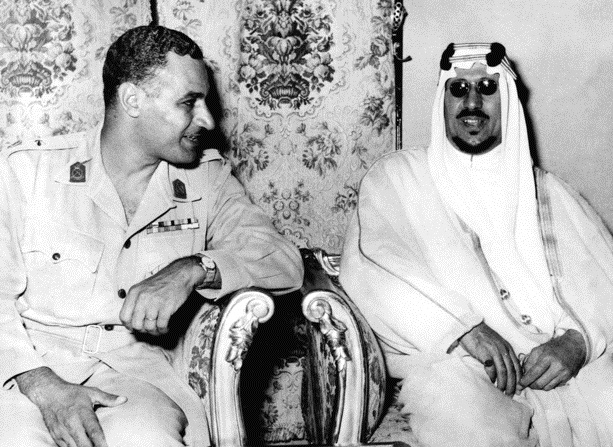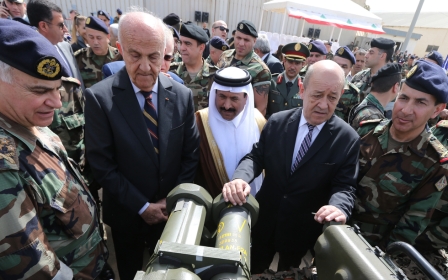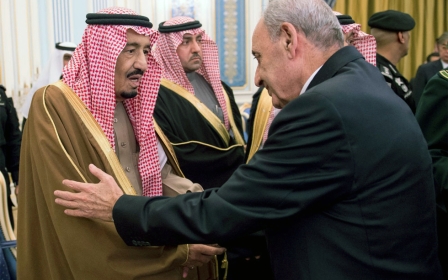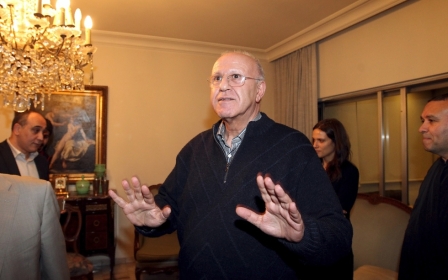Burning bridges: The Saudi Arabia-Iran conflict in historical context

It is fairly rudimentary for heads of state to make high profile visits to neighboring countries which seldom aim at enhancing mutual economic and security cooperation. The visit of the Saudi monarch Salman Bin Abdul Aziz to Egypt last weekend, however, goes beyond these protocols to reflect the overall regional tensions between the Kingdom of Saudi Arabia (KSA) and its allies and the Iranian axis. This schism has plunged the whole area into a Sunni-Shia war that extends from Yemen to Iraq, Syria and perhaps Lebanon, with no clear end in sight.
From the pulpit of the Egyptian parliament, the Saudi king pledged to dedicate the efforts of the Saudi-created Islamic alliance, which relies on Egypt for ground forces, to fighting terrorism. In this case, the definition of terrorism stretches to cover all and any efforts by Iran and its proxies to attack the standing of KSA in the region.
The most interesting fact however, is that this Saudi challenge to Iran was issued out of Egypt, which under nationalist president Gamal Abdul Nasser utilised a similar method to discredit and weaken the fairly young Saudi monarchy at the time.
While I do not propose in any way the cyclical nature of history which many tend to adopt, a historical understanding of regional rivalries - and particularly the Saudi-Egyptian one - may shed light on the future of the current standoff.
In 1952, the Free Officers Movement, led by a young Lt Colonel Gamal Abdul Nasser, toppled Egypt's King Farouk and declared the establishment of a revolutionary council to lead the new Egyptian Republic.
Nasser at the time was obsessed with making Egypt a regional superpower, so he was extremely cautious not to be branded as an anti-Western dictator but rather as a progressive leader geared towards building a modern state. His quest for modernity, at least from his perspective, included domesticating and reigning in the oil-producing Gulf states that at that time were still in the early stages of development.
Coincidently, Nasser was embraced by the Eisenhower administration at the time, which entrusted the execution of its policy in the region to so-called Arabists like Arch and Kermit Roosevelt Jr, grandsons of President Theodore Roosevelt. Just like the current Obama administration, Eisenhower was coaxed into believing that Nasser could be a moderate element and a far better partner to cooperate with than the somewhat backward Gulf states in the fight against communism.
However, the wishful thinking ended in 1956 when Nasser, after failing to get the necessary funding for his development project from the US and the World Bank, nationalised the Suez Canal, embarked on a plan to take over the Arab world under the banner of a newly-acquired version of Arab nationalism. Naturally Nasser was received by the Arab masses as a saviour and a reformer who would be able to win back Palestine from the Zionists.
During the reign of King Saud, Nasser received the support and aid of the Saudi monarch, who saw a potential ally in him. However, the relationship between the two rulers would fluctuate over time, especially after Saud became caught up in a power struggle with his brother, the more astute Prince Faisal.
In a strikingly similar fashion to what Iran is currently engaged in, Nasser’s expansionist spirit led him to support an Egyptian-style officers' coup in Yemen against the Hashemite Mutawakkilite kingdom. Nasser assumed that Yemen would be a political victory for him and his allies. But it ended up costing him a huge military investment of 40,000 troops deployed and an estimated casualty count of 10,000 men. Nasser’s Vietnam, as it become known, was partly due to Saudi support for the opposing side, the forces of the deposed Yemeni royalist forces.
Nasser’s humiliating exit from Yemen made him more aggressive elsewhere as he became more engaged in the Arab-Israeli conflict. His failure in the 1967 war led him to use the Palestine Liberation Organisation (PLO) as a vehicle for implementing his own vision and to keep the Palestinian card close at hand. Saudi Arabia would respond to this move by supporting the rise of the Fatah Movement, whose leader Yasser Arafat slowly rose up within the ranks of the Palestinian resistance and came to dominate the PLO.
Nasser and King Faisal’s feud would extend to different parts of the region but more so in the Levant, with Nasser meddling in the affairs of Syria, Jordan and Lebanon with various degrees of success. In Lebanon, the confrontation took a Cold War turn as both sides tried to directly (or via their allies) influence Lebanon’s standing vis-a-vis regional polarisation, a state strikingly similar to Lebanon’s current predicament within the Sunni-Shia standoff. Abdul Hamid Ghaleb, Nasser’s ambassador to Lebanon (1955-1967), was dubbed by many as the "Egyptian high commissioner" for his high-handed meddling in the county’s affairs.
Perhaps the apex of this conflict came in the spring of 1966 with the assassination of the anti-Nasser publisher of al-Hayat newspaper, Kamil Mrowa, by one Adnan Sultani, a zealous follower of a local Nasserite political faction.
While the assassination of Lebanese Prime Minister Rafik al-Hariri decades later had other surrounding factors, both murders were in fact messages directed towards Saudi Arabia. Mrowa, who opposed Nasser’s brand of Arab nationalism, was very close to the Saudi monarch. His killing was a direct insult to Faisal and the kingdom. Saudi Arabia's response to this message came a year later, as King Faisal tried to punish the Lebanese state for its laxity in dealing with the case.
King Faisal and Saudi Arabia by extension decided to suddenly withdraw their funds from Bank Intra, Lebanon’s foremost bank, where it was one of the main depositors, leading to a run on the bank that eventually led it to declare bankruptcy. The Intra debacle was a blow to the Lebanese economy and an indication of the dire political upheavals to come.
Back when Nasser and Faisal were duking it out, Iran under the Shah had sided with the latter, for obvious reasons. However, Iran’s role in the area has greatly shifted as now it has replaced Egypt as a serious contender for regional control. However, Iran is not really in a much better position than Egypt as it lacks the transnational lure of Arab nationalism which made Nasser a demigod. Neither Iran nor its allies can claim to possess this character.
As it stands, Iran’s military and political conquests have helped unite the Sunni factions under a joint vision hostile to Iran and its auxiliaries, the Houthis in Yemen and Hezbollah in Lebanon. And for Iran to be able to continue its project without plateauing requires a set of hard-to-achieve conditions. Iran is incapable of appealing to the Sunni masses, who view their projects as essentially a neo-Persian anti-Arab endeavour. Second, this expansionist project requires a strong and healthy economy which, to put it mildly, Iran certainly lacks.
More importantly, Iran's current ability to operate without oversight across the region stems from an explicit decision by the Obama administration to disengage from Middle Eastern affairs and to abandon the US’s traditional Sunni allies. However, it is prudent to remember that Obama’s term is nearing its end, and whoever is elected to replace this aloof administration will undoubtedly re-engage Saudi Arabia and weaken the Iranian influence.
Ultimately, the history of Egyptian-Saudi relations and the current events that have unfolded stand as an example of how regional changes might unfold. While Nasser wanted to destroy and topple the Saudi monarchy, his current successor President Abdel Fattah al-Sisi has agreed to relinquish sovereignty of two Egyptian Islands to Saudi Arabia, which will be used to link both countries via a suspension bridge. Perhaps a similar fate will await Saudi-Iranian relations in the not so distant future.
- Makram Rabah is a PhD candidate at Georgetown University’s history department. He is the author of A Campus at War: Student Politics at the American University of Beirut, 1967–1975 and a regular columnist for Now Lebanon.
The views expressed in this article belong to the author and do not necessarily reflect the editorial policy of Middle East Eye.
Photo: Saudi Arabia's King Saud ibn Abd al-Aziz (R) and Egyptian President Gamal Abdel Nasser confer in March 1956 at Kubbeh Palace in Cairo (AFP/INTERCONTINENTALE).
New MEE newsletter: Jerusalem Dispatch
Sign up to get the latest insights and analysis on Israel-Palestine, alongside Turkey Unpacked and other MEE newsletters
Middle East Eye delivers independent and unrivalled coverage and analysis of the Middle East, North Africa and beyond. To learn more about republishing this content and the associated fees, please fill out this form. More about MEE can be found here.





